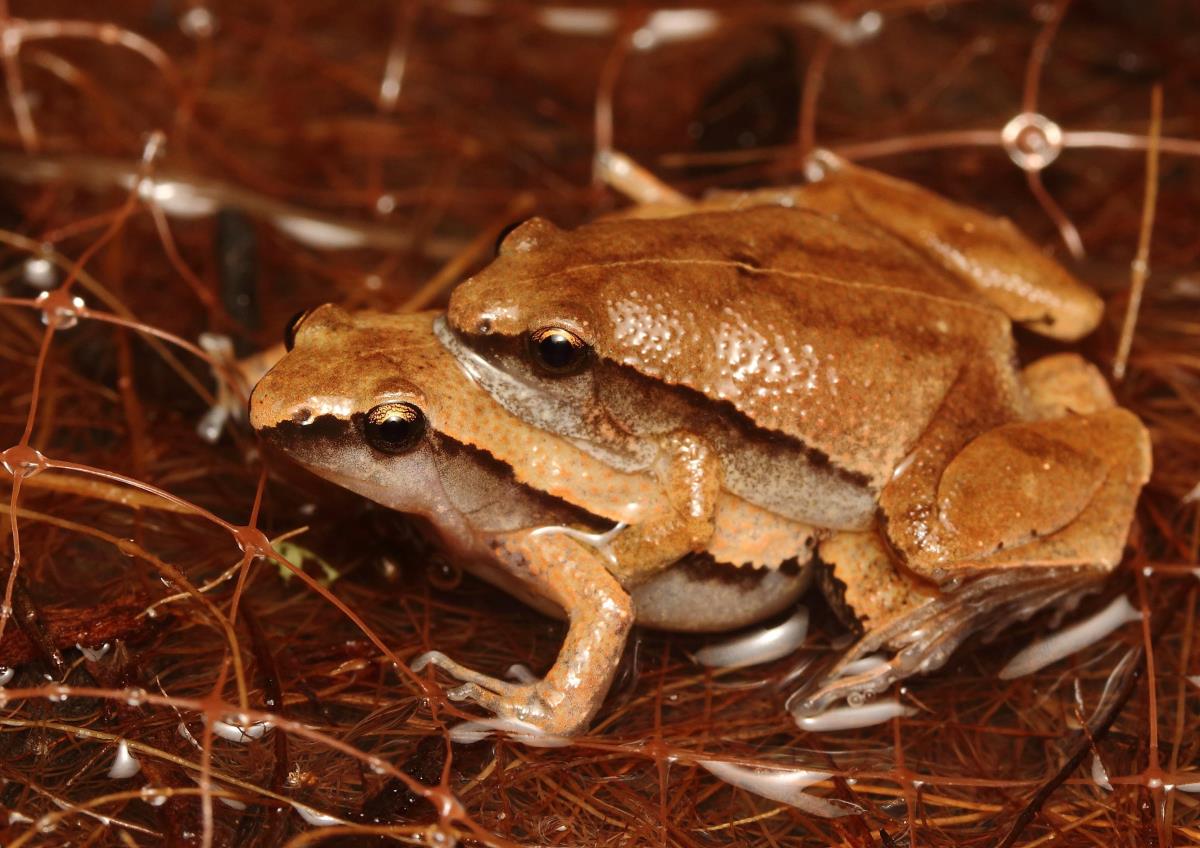Amphibians of Jurong Lake Gardens
Green Paddy Frog
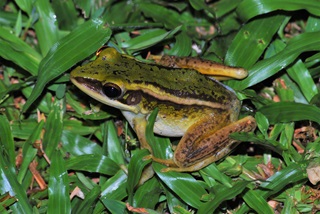 Photo credit: Daniel Ng (NParks) Photo credit: Daniel Ng (NParks) |
| Scientific name: | Hylarana erythraea |
| Common name: | Green Paddy Frog |
| Family: | Ranidae |
 Male: 4.5 cm Male: 4.5 cm
Female: 7.5 cm Tadpoles: 3 cm |
 What does it look like?
What does it look like?
This is a common frog found in Singapore. It has a distinctive white band running along the side of its body and a white upper lip. Its top side is usually bright green, and sometimes brown.
 Behaviour and Ecology
Behaviour and Ecology
Diet and Behaviour
The Green Paddy Frog feeds mainly on insects and is generally nocturnal.
Where are they found?
You can spot them along the banks of freshwater bodies such as Jurong Lake, as well as at other ponds and reservoirs. Their large tadpoles can be found in still waters, such as in ponds and ditches.
They can be found in many countries across Southeast Asia.
Did you know?
As amphibians such as the Green Paddy Frog require clean aquatic habitats to thrive, they often act as biological indicators of the health of the ecosystem.
Günther's Frog
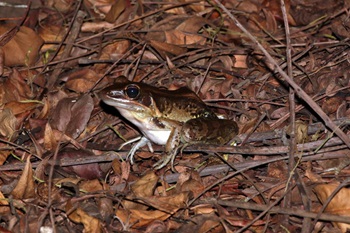 Photo credit: Noel Thomas (NParks) Photo credit: Noel Thomas (NParks) |
| Scientific name: | Sylvirana guentheri |
| Common name: | Günther's Frog |
| Family: | Ranidae |
 8 cm 8 cm |
 What does it look like?
What does it look like?
This introduced frog has a pale brown back, dark brown sides and a distinctive large eardrum surrounded by a light yellow ring. This species can be spotted in the freshwater swamp at Jurong Lake Gardens.
 Behaviour and Ecology
Behaviour and Ecology
Diet and Behaviour
They feed mainly on invertebrates and are often found in disturbed habitats.
Where are they found?
Its native range includes southern China and Vietnam, but it has been introduced to the islands of Guam and Singapore. Usually found in open swampy habitats, it thrives in human-disturbed habitats as well.
It is thought to have been introduced to Singapore via ornamental plants. Its calls were first heard in Singapore in 1997.
Did you know?
Günther's Frog has toxic skin secretions that are known to be lethal to other frogs in enclosed environments.
Four-lined Tree Frog
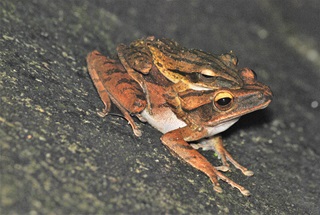 Photo credit: Daniel Ng (NParks) Photo credit: Daniel Ng (NParks) |
| Scientific name: | Polypedates leucomystax |
| Common name: | Four-lined Tree Frog |
| Family: | Rhacophoridae |
 Male: 5.5 cm Male: 5.5 cm
Female: 7.5 cm Tadpoles: 3 cm |
 What does it look like?
What does it look like?
Individuals in Malaysia and Singapore tend to have a series of dark stripes on their upper bodies, while those in Java and other territories may have spotted or speckled forms. Their snouts are pointed and only their hind feet are webbed. While they are a relatively small species, females are generally stouter than their male counterparts. Their large tadpoles have a pale spot on the tip of their snout.
 Behaviour and Ecology
Behaviour and Ecology
Diet and Behaviour
They feed on insects at night. They live on plants and breed at the edge of shallow pools, where they build nests made of foam on plants or rocks. This foam protects its fertilised eggs.
They have a loud, distinctive call which is a loud, nasal duck-like quack often heard during rainstorms, making them easily recognisable in our parks and gardens.
Where are they found?
The Four-lined Tree Frog has adapted to many environments and can live in forest edges, wetlands, shallow pools and urban areas. They can be found in Singapore and many other parts of Southeast Asia.
Banded Bull Frog
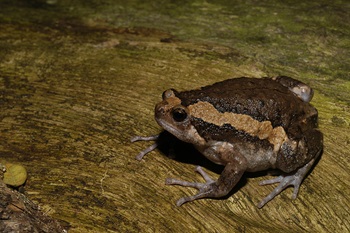 Photo credit: Alex Figueroa, NParks Flora&Fauna Web Photo credit: Alex Figueroa, NParks Flora&Fauna Web |
| Scientific name: | Kaloula pulchra |
| Common name: | Banded Bull Frog |
| Family: | Microhylidae |
 Male: 7 cm Male: 7 cm
Female: 7.5 cm |
 What does it look like?
What does it look like?
This chubby frog has a relatively small head, making its body look very round. Its toes are elongated with blunt tips. It is easily identified by the thick, black-edged, pale orange bands that extend from its head and down to the sides of its body. You can usually hear its loud, cow-like bellows before and after heavy rain in built-up urban areas.
 Behaviour and Ecology
Behaviour and Ecology
Diet and Behaviour
The Banded Bull Frog feeds mainly on small invertebrates such as ants and termites. When threatened, it will inflate itself while releasing poisonous mucus.
Where are they found?
It is a highly adaptable species that thrives in disturbed habitats like flooded grasslands, roadside puddles and urban drains. In the day, it hides in burrows under leaf litter or in the crevices of walls or buildings. The Banded Bull Frog is found in southern China, southern India, Sri Lanka and Southeast Asia.
Did you know?
Despite being very slow, these frogs are voracious eaters. They can consume up to a few hundred ants in a single night!
East Asian Ornate Chorus Frog
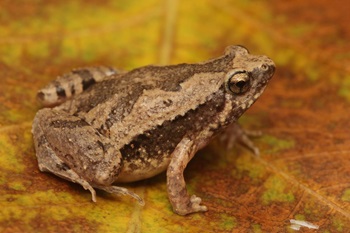 Photo credit: Law Ing Sind Photo credit: Law Ing Sind |
| Scientific name: | Microhyla fissipes |
| Common name: | East Asian Ornate Chorus Frog |
| Family: | Microhylidae |
 Adult: 2.5 cm Adult: 2.5 cm
Tadpole: 2.2 cm |
 What does it look like?
What does it look like?
It is a tiny frog about the size of a small marshmallow, with equally small tadpoles. It has a small and pointed head, and long and slender hind legs. Its body is triangular in shape and is olive brown in colour, with a pale stripe running down both sides of its body.
 Behaviour and Ecology
Behaviour and Ecology
Diet and Behaviour
These frogs are nocturnal and feed mainly on insects. They lay their eggs in muddy puddles.
Where are they found?
This frog is found in central China, Japan and Taiwan and the Malay Peninsula. They are believed to have been introduced to Singapore, and specimens were first found on Pulau Tekong in 2005. They live in many types of habitats like lowland forests, grasslands and urban areas.
Dark-sided Chorus Frog
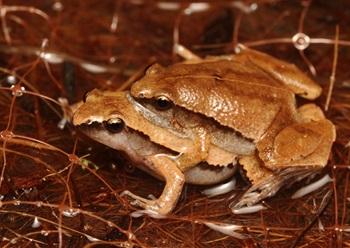 Photo credit: Law Ing Sind Photo credit: Law Ing Sind |
| Scientific name: | Microhyla heymonsi |
| Common name: | Dark-sided Chorus Frog |
| Family: | Microhylidae |
 Adult: 2.5 cm Adult: 2.5 cm
Tadpole: 1.5 cm |
 What does it look like?
What does it look like?
This tiny native frog is similar in both size and shape to the introduced East Asian Ornate Chorus Frog but is yellowish brown with a thin white stripe along its back and a white belly. It has distinctive black bands running along its sides. Tadpoles have a white band over their heads.
 Behaviour and Ecology
Behaviour and Ecology
Diet and Behaviour
These frogs are nocturnal and feed on insects. Due to their tiny size, they are often overlooked but their loud calls in the evening, which are a series of rapidly repeating loud kriiiiik sounds, usually give away their presence.
Where are they found?
The distribution of this species ranges from southern China to the Malay Peninsula, Singapore and Sumatra. They are often found near small puddles and ponds in rural areas, parks and gardens. They are also found on offshore islands like Pulau Ubin and Pulau Tekong.
Field Frog
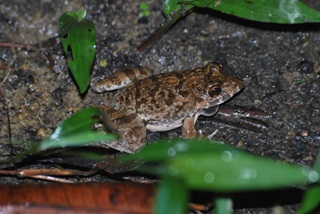 Photo credit: Daniel Ng (NParks) Photo credit: Daniel Ng (NParks) |
| Scientific name: | Fejervarya limnocharis |
| Common name: | Field Frog |
| Family: | Dicroglossidae |
 Adult: 6 cm Adult: 6 cm
Tadpole: 2.5 cm |
 What does it look like?
What does it look like?
It has muscular hind legs with half-webbed hind feet. Its back is grey or brown with irregular black blotches.
 Behaviour and Ecology
Behaviour and Ecology
Diet and Behaviour
These frogs are nocturnal and feed on insects. Its tadpoles live at the bottom of shallow puddles and ditches. Its calls are similar to the Asian Toad but start off slow and get faster towards the end. They lay large clutches of eggs in stagnant water.
Where are they found?
It is a common native frog that can be found in built-up urban areas, gardens, and nature reserves. Its distribution ranges from India and Sri Lanka, South China, East Asia down to Thailand, Peninsular Malaysia, Singapore and Indonesia.
Crab-eating Frog
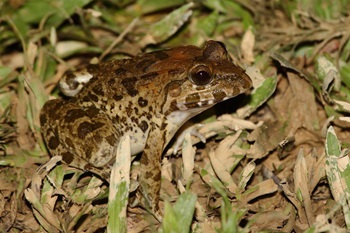 Photo credit: Law Ing Sind Photo credit: Law Ing Sind |
| Scientific name: | Fejervarya cancrivora |
| Common name: | Crab-eating Frog |
| Family: | Dicroglossidae |
 Male: 8 cm Male: 8 cm
Female: 10 cm Tadpole: 4 cm |
 What does it look like?
What does it look like?
These are large frogs with similarly large tadpoles. Despite being much larger than the Field Frog, smaller individuals can still be misidentified due to their similar markings. However, this species differs from the Field Frog as its hind limbs are extensively webbed.
 Behaviour and Ecology
Behaviour and Ecology
Diet and Behaviour
Despite their name, they mostly feed on insects at night. However, they are generalists and will also consume crustaceans like Tree-climbing Crabs in the mangroves. Their calls sound like gargling, making them stand out from other frogs in the area.
Where are they found?
In Singapore, they can be found in both freshwater and brackish water environments like mangroves. Outside of Singapore, they can be found in India, Indochina, Sri Lanka and across Southeast Asia.
Did you know?
The Crab-eating frog can tolerate salt water. It can adjust its body to adapt from freshwater to seawater within a few hours. It does this by increasing and retaining the urea concentration in its body, so it doesn’t lose water to its surroundings through osmosis!
Asian Toad
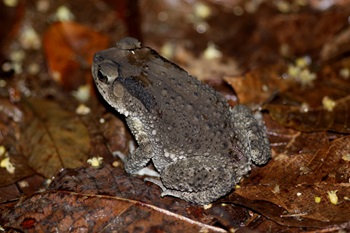 Photo credit: Holly Siow, NParks Flora&Fauna Web Photo credit: Holly Siow, NParks Flora&Fauna Web |
| Scientific name: | Duttaphrynus melanostictus |
| Common name: | Asian Toad |
| Family: | Bufonidae |
 Adult: 11 cm Adult: 11 cm
Tadpole: 2.7 cm |
 What does it look like?
What does it look like?
Being a true toad, it has a stout body and dry skin, unlike frogs which have moist skin. Several bony ridges run along the top of its head, while the raised glands behind its eyes (lightly coloured ovals) are very obvious. Two black stripes run down the top of its head as well. Their tadpoles are tiny and blackish, about the size of a 10-cent coin.
 Behaviour and Ecology
Behaviour and Ecology
Diet and Behaviour
The Asian Toad feeds mainly on a wide range of invertebrates at night. Adult toads are usually found under the cover of rocks, leaf litter and logs during the day. They are known to sit under street lamps at night where they catch insects attracted to light.
Where are they found?
This native species can be found almost everywhere in Singapore. It is also widely distributed across East Asia and Southeast Asia, and has been introduced to Australia, Madagascar and Papua New Guinea.
Did you know?
When it feels threatened, it will inflate its body. It is also able to secrete toxins from its body to deter predators.
Banner: Dark-sided Chorus Frog. Photo credit: Law Ing Sind


